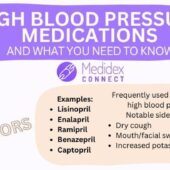What is an EpiPen? EpiPen is an auto-injector device that delivers epinephrine, which is a medication used to treat severe, life-threatening allergic reactions known as anaphylaxis. Anaphylaxis can be triggered by food, medication, insect stings, venom, or latex and can lead to severe symptoms within seconds to minutes. Epinephrine helps to reverse these severe symptoms, reduce swelling, open the airway, and maintain heart function and blood pressure. Symptoms of anaphylaxis may include generalized hives, swelling of the mouth and throat, difficulty breathing or wheezing, vomiting, and low blood pressure. Immediate treatment is crucial; if left untreated, anaphylaxis can progress to anaphylactic shock and even death.
Have questions about using an EpiPen? If you don’t find them in the article below or want more information, talk to a pharmacist online 24/7 using Medidex Connect.
How fast does Epinephrine work?
Epinephrine takes effect immediately after injection but may take 5 to 10 minutes to reach its full effect. It begins to wear off within 20 to 30 minutes. If the reaction has not subsided, a second dose can be administered.

Epinephrine is administered using an auto-injector, available in various strengths, and dosage is based on the patient’s weight.
Epinephrine dosages
EpiPen epinephrine auto-injectors dosages
- 0.15 mg for children less than 66 lbs
- 0.3 mg for children and adults over 66 lbs
Auvi-Q epinephrine auto-injectors dosages
- 0.10 mg for infants and toddlers 16.5 lbs to 33 lbs
- 0.15 mg for patients who weigh 33 lbs to 66 lbs
- 0.3 mg for patients who weigh 66 lbs or more

Symjepi epinephrine auto-injectors dosages
- 0.15 mg for patients who weigh 33 lbs to 66 lbs
- 0.3 mg for patients who weigh 66 lbs or more

How to Administer an Epinephrine Auto-Injector
Steps for Administering EpiPen Epinephrine Auto-Injector
- Remove it from the carrying case and pull off the blue safety release.
- Keep your thumb, finger, and hand away from the orange (needle) end of the device.
- Inject into the middle of the outer thigh only at a 90-degree angle.
- Push the auto-injector firmly until it “clicks.” The click signals that the injection has started.
- Hold the needle firmly in place while counting to 3.
- Remove the needle and massage the area for 10 seconds.
- After injection, the orange tip will extend to cover the needles. If the needle is visible, it should not be reused.

Steps for Administering Auvi-Q Epinephrine Auto-Injector
- Pull Auvi-Q up from its outer case.
- Pull the red safety guard down and off of Auvi-Q.
- Place the black end of Auvi-Q against the middle of the outer thigh, then push firmly until you hear a click and hiss sound, and hold in place for 2 seconds.
Steps for Administering Symjepi Epinephrine Auto-Injector
- Pull the cap off, and do not touch the plunger until the needle is fully inserted.
- While seated, hold the device with finger grips.
- Face the needle downward and slowly insert it into the thighs.
- Once the needle is in the thigh, push the plunger down until it clicks.
- Hold for 2 seconds.
- Remove the syringe and massage for 10 seconds.
- Once an injection has been given, use one hand with your finger behind the needle to slide the safety guard up until it clicks to cover the needle
Alternatives to EpiPen and Epinephrine Auto-Injectors
- Epinephrine kits come with vials or ampules and are a last resort for those unable to afford injection devices.
- A kit, which includes two doses, needles, and a syringe, costs ~$20.
- Due to dosing errors and treatment delays, epinephrine kits with vials or ampules are a better fit for institutions and clinics.
What is the Cost of EpiPen and Epinephrine Auto-Injectors
- The price of the product can vary based on the pharmacy, insurance plan, and manufacturer.
- EpiPen is also available in a generic form called epinephrine.
- Co-pay cards are available for most US manufacturers to help reduce cost.
- Co-pay cards can be printed or saved on a smartphone and presented at the pharmacy.
- EpiPen or EpiPen Jr: $610 (co-pay card)
- Epinephrine auto-injector generic: $300 (co-pay card)
- Auvi-Q: $620 (co-pay card)
- Symjepi: $250 (co-pay card)
Side effects of Epinephrine and EpiPen
- Headache
- Anxiety
- Nervousness
- Sweating
- Nausea or vomiting
- Difficulty breathing
- Paleness
- Irregular heartbeats
- Dizziness
Overdose of Epinephrine
- Excessive dose of epinephrine has the potential to elevate arterial pressure, which in turn can lead to cerebrovascular hemorrhage.
- Pulmonary edema may develop as a result of peripheral vascular constriction and concurrent cardiac stimulation.
- The administration of treatment involves the use of rapidly acting vasodilators, alpha-adrenergic blocking drugs, and/or respiratory support.
Epinephrine Warnings and Precautions
- EpiPen should only be injected into the middle of the outer thigh.
- Do not inject into your veins, fingers, toes, buttocks, feet, or hands.
- Always carry 2 EpiPens with you because sometimes a single dose may not be enough.
- Skin infections can occur after injections, so report any prolonged swelling, redness, warmth, or tenderness at the injection site.
Epinephrine Key Counseling Points
- The EpiPen and its generic two-pack each come with a training device.
- These training devices resemble the actual device but do not have a needle. Patients and parents can use them repeatedly to practice proper administration.
- Each epinephrine injection has a different administration technique for proper use.
- All products can be injected through clothing.
- Refrigeration is not necessary.
- If the medication changes to a pinkish or brown color when exposed to heat or light, it should not be used.
- Always check the device to ensure the medication is clear and not expired.
- It is normal to see liquid remaining in the device after injection.
- If additional care is needed, call for emergency help.
- When injecting an uncooperative child, hold the leg firmly to avoid bending or breaking the needle.
If you have additional questions about EpiPens, epinephrine auto-injectors, or epinephrine in general you can connect with a licensed pharmacist on-demand using Medidex Connect.
Disclaimer: This website does not provide medical advice. No content on this site is intended to be a substitute for professional medical advice, diagnosis, or treatment. All content on this site is for educational and informational purposes only, does not constitute medical advice, and does not establish any kind of patient-provider or client-professional relationship by your use of this website. Although we strive to strictly provide accurate and up to date general information, content available on this site is not a substitute for professional medical advice, and you should not rely solely on the information provided here. Always seek the advice of your physician or other qualified healthcare provider with any questions you may have regarding medical conditions, treatments, or medications.




















